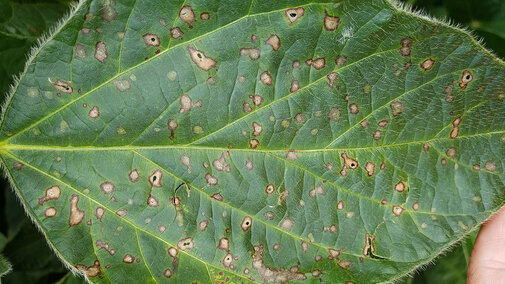Moderate to severe frogeye leaf spot is being reported on soybean in northeast Nebraska and may be occurring in other areas of the state, especially on susceptible varieties. Scouting is advised to determine incidence and severity before making a treatment decision.
Although QoI (formerly called strobilurin) fungicides have historically been most effective in managing the disease, pathogen resistance to products in this class has been widely documented in other states, including four counties each in South Dakota and Iowa.
We suspect pathogen resistance to QoI in at least two Nebraska fields and are currently testing samples. When spraying for frogeye leaf spot, we recommend a product with two or more active ingredients from multiple fungicide classes.
If you believe a fungicide application did not slow the spread of this disease, please contact the author via email at tjackson3@unl.edu or via Twitter at @tjcksn so a sample can be tested for resistance. Please collect a gallon food storage bag of symptomatic leaves prior to an additional fungicide application, refrigerate the sample, and contact Jackson-Ziems so it can be tested.
Samples also can be sent to the university's Plant and Pest Diagnostic Clinic in Lincoln. Sample forms, the clinic's mailing address, and collection instructions can be found on the site.
Frogeye leaf spot infection can occur at any stage of soybean development, but most often occurs after flowering and is typically in the upper canopy. Initial symptoms are small, dark spots on the leaves. Spots eventually enlarge to a diameter of about ¼ inch and the centers of the lesions become gray to brown and have a reddish-purple margin. Individual leaf spots can coalesce to create irregular patterns of blighting on the leaf.
More Information
For more information on identifying and treating frogeye leaf spot in soybean see:
- Frogeye Leaf Spot (publication CPH-1017), and Frogeye Leaf Spot of Soybean, published by the Crop Protection Network, and
- Frogeye Leaf Spot, including a short video on Frogeye Leaf Spot Identification and Management, in the Plant Disease section of CropWatch.unl.edu.

